|
|
 |
Fiche d'espèce de Copépode |
|
|
Calanoida ( Ordre ) |
|
|
|
Arietelloidea ( Superfamille ) |
|
|
|
Augaptilidae ( Famille ) |
|
|
|
Centraugaptilus ( Genre ) |
|
|
| |
Centraugaptilus horridus (Farran, 1908) (F,M) | |
| | | | | | | Syn.: | Augaptilus horridus Farran, 1908 b (p.78, Descr.F, fig.F); Sewell, 1913 (p.354);
? Augaptilus pyramidalis Esterly, 1911 (p.334, figs.F);
? Centraugaptilus pyramidalis : Brodsky, 1950 (1967) (p.389, figs.F, Rem.); Mauchline, 1998 (p.68: F) | | | | Ref.: | | | Sars, 1925 (p.307, figs.F,M); Sewell, 1932 (p.326, figs.M); Rose, 1933 a (p.233, figs.F,M); Jespersen, 1934 (p.114); 1940 (p.62); Sewell, 1947 (p.232, Rem.); Tanaka, 1964 b (p.83, figs.F,M); Vervoort, 1965 (p.147, Rem.); Krishnaswamy & al., 1967 (p.331, Rem.: Mx2); Owre & Foyo, 1967 (p.88, figs.F,M); Tanaka & Omori, 1967 (p.258); Minoda, 1971 (p.41); Matthews, 1972 (p.56); Boxshall, 1985 (p.348, figs.); Huys & Boxshall, 1991 (p.359, fig.); Bradford-Grieve & al., 1999 (p.882, 939, figs.F,M); Bradford-Grieve,1999 b (p.45, figs.F,M, figs.171, 190); Vives & Shmeleva, 2007 (p.179, figs.F,M, Rem.) |  issued from : O. Tanaka in Publs Seto Mar. Biol. Lab., 1964, XII (1). [p.83, Fig.215]. Female: a, habitus (dorsal); b, forehead (left lateral side); c, last thoracic segment and urosome (left lateral side); d, rostrum (frontal view); e, exopod of P1; f, P5. Nota: The urosome segments and furca are in the proportional lengths as 42:13:29:16 = 100. A1 reaches back to the posterior margin of the 3rd thoracic segment. Male: g, P5. Nota: The urosome segments and furca are in the proportional lengths as 32:13:13:10:26:16 = 100. Grasping of A1 on the left side.
|
 Issued from : G.O. Sars in Résult. Camp. Scient. Prince Albert I, 69, pls.1-127 (1924). [Pl.CVII, figs.11-18]. Female: 11, habitus (dorsal); 12, rostrum; 13, distal portion of Mxp; 14, terminal segment of Mxp (enlarged); 15, P1; 16, P5. Male: 17, forehead (lateral); 18, P5.
|
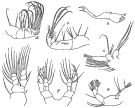 Issued from : R.B.S. Sewell in Mem. Indian Mus., 1932, X (continued). [p.327, Fig.107]. Male (from off SE Sri Lanka): a, A2; b, Md; c, Mx1; d, Mx2; e, Mxp; f, P1; g, P5.
|
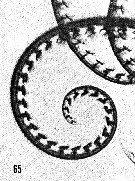 issued from : H.B. Owre & M. Foyo in Fauna Caribaea, 1, Crustacea, 1: Copepoda. Copepods of the Florida Current. 1967. [p.19, Fig.65]. Female: 65, terminal setae of Mx2.
|
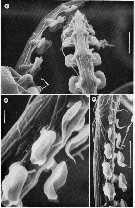 issued from : G.A. Boxshall inPhil. Trans. R. Soc. Lond., 1985, B 311. [Plate 1, 47-49]. 47, button seta on Mx2, showing zone of transition between normal setule and button; 48, back and side views of button setae; 49, detail of buttons. Scale bars: 0.010 mm (47-48; 0.002 mm (49). The transition from normal setule to stalked button occurs over a short distance and shows that the buttons are modified setules. Their paired arrangement and stalks are also shown in figures 48 and 49. Itis assumed that the button setae are involved in prey capture and holding. Their position on the distal portions of the raptorial limbs also suggests a role in the grasping action. There are 11 button setae, only 4 on the maxilliped, here interpreted as evidence of the dominant role of the maxillae in prey capture. The role of the buttons themselves is unclear. It is probably to increase the surface area of the seta that comes into contact with the prey and to protect these primary feeding setae from damage. The stalked buttons may act as buffers, absorbing some ofthe energy generated by the struggling prey, thereby protecting the seta, which cannot be replaced once damaged as adult copepods do not moult. The prey is grasped directly by the button setae.
|
 issued from : C.O. Esterly in Univ. Calif. Publs Zool., 1911, 6 (14). [Pl.26, Figs.1, 9]. As Augaptilus pyramidalis. With doubt. Female (from San Diego Region):1, habitus (dorsal); 9, habitus (lateral). Nota: In side view the forehead is pyramidal in shape and overhangs the rostrum, which is very strong and heavy. Cephalothorax 5-segmented and the abdomen 3-segmented; the former is six and one-half times as long as the urosome. Genital segment as long as the rest of the urosome. A1 reach the posterior border of the 2nd thoracic segment. Exo and endopod of A2 of equal lengths. Bristles of Mxp well equiped with augaptiloid cups.
|
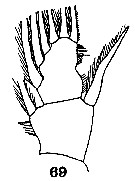 issued from : C.O. Esterly in Univ. Calif. Publs Zool., 1911, 6 (14). [Pl.30, Fig.69]. As Augaptilus pyramidalis. With doubt. Female: 69, exopod of P1. Nota: Rami of P1 2-segmented and the 1st segment of exopod has an unusually long and heavy spine; rami of the other pairs of feet 3-segmented and the end segments of endopod with 7, 8, 8, 7, 6, bristles in the P1 to P5.
|
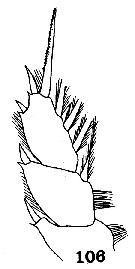 issued from : C.O. Esterly in Univ. Calif. Publs Zool., 1911, 6 (14). [Pl.32, Fig.106]. As Augaptilus pyramidalis. With doubt. Female: 106, exopod of P5.
|
 issued from : G.P. Farran in Fish. Ire. Sci. Invest., 1906, II [1908]. [Pl. VIII, Fig.20]. As Augaptilus horridus. Female (from W Ireland): 20, cephalon (lateral).
|
 issued from : H.B. Owre & M. Foyo in Fauna Caribaea, 1, Crustacea, 1: Copepoda. Copepods of the Florida Current. 1967. [p.92, Fig.649]. Female (23°36'N, 83°06'W): 649, P5.
|
 issued from : H.B. Owre & M. Foyo in Fauna Caribaea, 1, Crustacea, 1: Copepoda. Copepods of the Florida Current. 1967. [p.19, Fig.64, 65]. Female: 64, Mx2; 65, terminal setae of Mx2.
| | | | | Ref. compl.: | | | Lysholm & al., 1945 (p.40); Sewell, 1948 (p.505, 522, 538, 548, 558, 561); C.B. Wilson, 1950 (p.185); De Decker & Mombeck, 1964 (p.11); Grice & Hulsemann, 1967 (p.18); Roe, 1972 (p.277, tabl.1, tabl.2); Björnberg, 1973 (p.348, 385); Deevey & Brooks, 1977 (p.156, tab.2, Station "S"); Carter, 1977 (1978) (p.36); Vives, 1982 (p.294); Guangshan & Honglin, 1984 (p.118, tab.); Lozano Soldevilla & al., 1988 (p.60); Heinrich, 1990 (p.18); Errhif & al., 1997 (p.422); Holmes, 2001 (p.10); Galbraith, 2009 (pers. comm.); Schnack-Schiel & al., 2010 (p.2064, Table 2: E Atlantic subtropical/tropical); in CalCOFI regional list (MDO, Nov. 2013; M. Ohman, comm. pers.) | | | | NZ: | 15 | | |
|
Carte de distribution de Centraugaptilus horridus par zones géographiques
|
| | | | | | | Loc: | | | South Africa (E), Atlant. (tropical), G. of Guinea, Canary Is., Morocco, off Madeira, Azores, Caribbean Sea, Florida, off Bermuda: Station ‘’ S’’ (32°10’N, 64°30’W), Bay of Biscay, off W Ireland, off W Scotland, S Iceland, S Denmark Strait, Indian (G. of Oman, Arabian Sea, SW Madagascar, Natal, Bay of Bengal), S Indian (subtropical convergence), Philippines, Japan (Izu), Bering Sea, Vancouver Is., California (San Diego), Pacif. (tropical) , off Panama, off Peru, Pacif. (SE tropical), Chile, Pacif. (W equatorial), New Zealand (South Island SE) | | | | N: | 32 | | | | Lg.: | | | (1) F: 9,6; (11) F: 7-6; M: 8,4; (16) F: 8,55-5,6; (24) F: 10; (44) M: 8,4; (49) F: 7,5; (69) F: 9,45; M: 8,33; (70) F: 10,1-8,8; (143) F: 6,68; (199) F: 7,2-6,24; (208) F: 9,5; {F: 5,60-10,10; M: 8,33-8,40} | | | | Rem.: | bathypélagique.
On observe de grandes différences de taille.
Voir aussi les remarques en anglais | | | Dernière mise à jour : 03/12/2020 | |
|
|
 Toute utilisation de ce site pour une publication sera mentionnée avec la référence suivante : Toute utilisation de ce site pour une publication sera mentionnée avec la référence suivante :
Razouls C., Desreumaux N., Kouwenberg J. et de Bovée F., 2005-2026. - Biodiversité des Copépodes planctoniques marins (morphologie, répartition géographique et données biologiques). Sorbonne Université, CNRS. Disponible sur http://copepodes.obs-banyuls.fr [Accédé le 08 janvier 2026] © copyright 2005-2026 Sorbonne Université, CNRS
|
|
 |
 |














